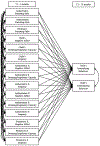Interaction between maternal and paternal parenting styles with infant temperament in emerging behavior problems
- PMID: 31103746
- PMCID: PMC6858519
- DOI: 10.1016/j.infbeh.2019.04.005
Interaction between maternal and paternal parenting styles with infant temperament in emerging behavior problems
Abstract
This study examined the interaction effects of infant temperament (negative affect, orienting/regulatory capacity, surgency) on the relationship between maternal and paternal parenting styles (authoritative, authoritarian, permissive) and externalizing and internalizing behaviors simultaneously. A diverse sample of mothers (N = 186) and fathers (N = 142) reported on infant temperament of their 6-month-olds and their children's internalizing and externalizing behaviors one year later. Significant interactions revealed: (a) surgency moderated maternal authoritative and paternal permissive parenting style and externalizing behaviors; and (b) surgency moderated maternal authoritarian and paternal authoritative parenting style and internalizing behaviors. No significant interactions were found between maternal and paternal parenting styles and their report of their infants' orienting/regulatory capacity and negative affect. Findings suggest interaction effects may appear beginning in infancy.
Keywords: Externalizing behavior problems; Infant temperament; Internalizing behavior problems; Longitudinal; Moderation; Parenting styles.
Copyright © 2019 Elsevier Inc. All rights reserved.
Figures





Similar articles
-
Emerging behavior problems: Bidirectional relations between maternal and paternal parenting styles with infant temperament.Dev Psychol. 2019 Jun;55(6):1199-1210. doi: 10.1037/dev0000707. Epub 2019 Feb 11. Dev Psychol. 2019. PMID: 30742467 Free PMC article.
-
Fathers' and mothers' attachment styles, couple conflict, parenting quality, and children's behavior problems: an intervention test of mediation.Attach Hum Dev. 2019 Oct;21(5):532-550. doi: 10.1080/14616734.2019.1582600. Epub 2019 Mar 1. Attach Hum Dev. 2019. PMID: 30821614 Clinical Trial.
-
Harsh parenting, child behavior problems, and the dynamic coupling of parents' and children's positive behaviors.J Fam Psychol. 2017 Sep;31(6):689-698. doi: 10.1037/fam0000310. Epub 2017 Mar 23. J Fam Psychol. 2017. PMID: 28333490 Free PMC article.
-
Externalizing symptoms, effortful control, and intrusive parenting: A test of bidirectional longitudinal relations during early childhood.Dev Psychopathol. 2015 Nov;27(4 Pt 1):953-68. doi: 10.1017/S0954579415000620. Dev Psychopathol. 2015. PMID: 26439056 Review.
-
Paternal feeding practices and styles: a systematic review.Nutr Rev. 2024 May 10;82(6):794-803. doi: 10.1093/nutrit/nuad090. Nutr Rev. 2024. PMID: 37500603
Cited by
-
Interactions between parenting styles, child anxiety, and oppositionality in selective mutism.Eur Child Adolesc Psychiatry. 2025 Jan;34(1):225-235. doi: 10.1007/s00787-024-02484-w. Epub 2024 Jun 4. Eur Child Adolesc Psychiatry. 2025. PMID: 38832963 Free PMC article.
-
The impact of children's temperament on recurrent unintentional injuries: the role of paternal parenting styles as a mediator.PeerJ. 2022 Oct 10;10:e14128. doi: 10.7717/peerj.14128. eCollection 2022. PeerJ. 2022. PMID: 36248711 Free PMC article.
-
Relationship between Paternal and Maternal Parenting Style with Internet Addiction Level of Adolescents.Iran J Psychiatry. 2021 Oct;16(4):438-443. doi: 10.18502/ijps.v16i4.7231. Iran J Psychiatry. 2021. PMID: 35082856 Free PMC article.
-
The Effects of Chinese Parenting Belief on Preschoolers' Temperament and Secure Attachment.Children (Basel). 2022 Dec 21;10(1):9. doi: 10.3390/children10010009. Children (Basel). 2022. PMID: 36670558 Free PMC article.
-
Correlation of Personality, Temperament, and Behavior of Children in the Dental Environment.Int J Clin Pediatr Dent. 2024 Aug;17(8):907-912. doi: 10.5005/jp-journals-10005-2867. Int J Clin Pediatr Dent. 2024. PMID: 39372349 Free PMC article.
References
-
- Achenbach TM, & Rescorla LA (2000). Manual for the ASEBA Preschool Forms & Profiles. Burlington, VT: University of Vermont, Research Center for Children, Youth, & Families.
-
- Baumrind D (1966). Effects of authoritative parental control on child. Child Development, 37, 887–907. 10.2307/l126611 - DOI
-
- Bell RQ (1968). A reinterpretation of the direction of effects in studies of socialization. Psychological Review, 72, 81–85. - PubMed
-
- Bell RQ (1979). Parent, child, and reciprocal influences. American Psychologist, 34, 821–826.
Publication types
MeSH terms
Grants and funding
LinkOut - more resources
Full Text Sources
Medical

